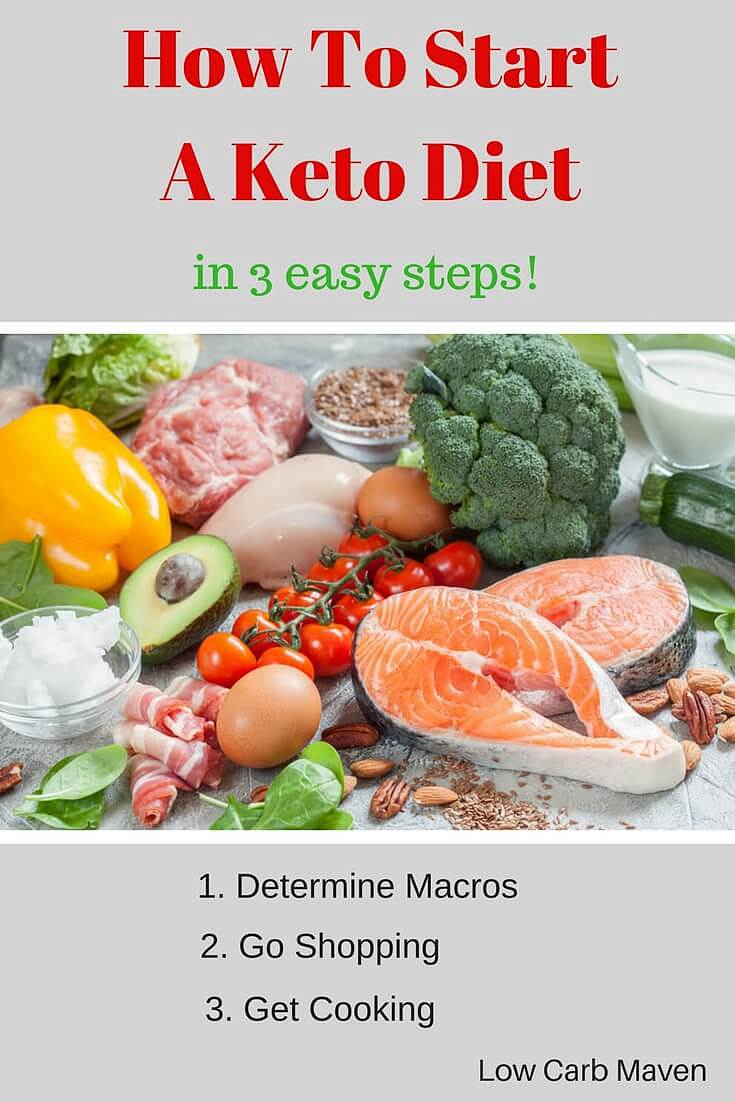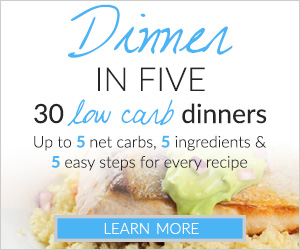Join the thousands of people who will choose a low carb keto lifestyle this month and learn how to start a low carb diet in 3 easy steps!

[This post may contain affiliate links. Purchasing through a link may result in my earning a small consideration.]
What is the Low Carb Keto Diet and why does it work?
A keto diet is a special low carb diet in which the body burns fats for fuel instead of carbohydrates. In the absence of carbohydrates, fats break down into ketone bodies which supply the brain and body with an almost unending and stable source of energy. Keto diets work because they stabilize blood sugars. Lowering glucose levels and avoiding large spikes in insulin is the secret to harnessing stored body fat for fuel (read more about this on Low Carb RN). The result is significant weight loss that’s easily maintained if one sticks to a low carb diet.
Following a low carb keto diet is easy. Choose the best quality food you can afford while avoiding grains, sugar and starches, (see my Low Carb Food List) Cook your own food, read food labels, and learn how to order at restaurants. As a rule, carbohydrates are counted instead of calories, however, this isn’t an excuse to get carried away. One of the benefits of keto diets is an increased feeling of satiety – you just aren’t as hungry and may actually eat less.
What Is low carb/Keto Flu?
The low carb or keto flu is a natural period of adjustment which occurs when the body switches from using carbs for fuel to using fats. The resulting symptoms are headaches, lethargy, and body aches. Symptoms can be remedied by drinking fluids containing electrolytes (bone broth, a cup of bouillon, pickle juice), salting your food, having some caffeine, using coconut oil for cooking, and taking it easy. Symptoms pass within a few days.
How To Start A Low Carb Diet In Three Easy Steps
- Determine your macros
- Shop
- Get cooking
ONE: Determine Your Macros
What are macros? Macros represent the amount of carbohydrates, fats, and proteins at which one should eat, daily. Individual macros are based upon gender, height, weight, age, activity level and body fat percentage. There are many macro calculators available online and I like this calculator from Tasteaholics. Meals and food are planned based upon individual macros. Some people try to “hit their macro” percentages at every meal while others look at their whole day.
NOTE: You do not have to determine your macros to follow a keto diet. Many people follow a keto diet simply by limiting net carbs to 20 a day while enjoying moderate amounts of protein and liberal amount of fat. To determine net carbs for a particular food, subtract fiber carbs from total carbs. A moderate amount of protein is 3-4 ounces of meat per meal. Enjoy cooking foods in fat, adding cream to coffee, using mayo and full fat dressings, topping vegetables with butter and eating cheese (limit cheese to 4 ounces a day because it does contain carbs).
How To Track Your Macros? There are many tools available to help track individual macros in the form of phone apps, Fitbits, and online tracking sites. I prefer online tracking sites and always recommend Fatsecret.com. I believe they have the most extensive ingredient lists for their nutritional calculators. My favorite feature is a pie chart which shows your macros in percentages as food are added to the food journal. Many keto dieters try to keep their macros around: 70-80% fat, 15-20% protein and 5-10% carbs. (See below.)
TWO: Go Shopping
Choose foods that are naturally low in carbs like green leafy vegetables and salad vegetables, full-fat dairy, eggs, nuts, seeds, and meats. Fresh, minimally processed ingredients are best. Processed foods contain sodium, preservatives, and added sugars so be sure to read labels. Look for sugar-free alternatives to condiments like ketchup and barbecue sauce or make your own. You’ll have to decide which sweeteners are right for you and how much you are willing to use.
It’s important to read food labels to determine the amount of carbs a product has per serving (subtract fiber from total carbs to determine net carbs). Many foods contain hidden sugars so err on the side of simplicity. Some people like to say, “if my great-grandma wouldn’t know what it is, then forget it.” For a complete list of safe foods see my Low Carb Foods List.
THREE: Get Cooking
Keep things simple for best weight loss results, but simple does not mean boring. Use spices, herbs, and plenty of fat to make food taste good. Cooking and preparing your own meals ensures that you hit your macros and control your carb intake. Protein can be grilled, pan fried, sauteed, or baked. Use enough fat so that your food doesn’t stick to the grill or a pan. One can also find many low carb keto crock pot and electric pressure cooker recipes online.
A Salad A Day Keeps The Doctor Away!
I can’t stress enough the importance of eating vegetables, especially a nice salad, on a low carb keto diet. Vegetables contain vitamins and minerals as well as fiber and water which help us feel full. A healthy salad provides adequate amounts of protein and fat through the addition of meats-fish-shellfish, cheese, eggs, nuts and seeds, and full-fat dressing. Even a large salad is low in carbs when modest amounts of low carb vegetables are added. If you can take the carbs, try adding a few berries for a burst of tart-sweet flavor.
Low Carb Keto Tips
Automate your meals in the beginning:
Make it easy on yourself and automate your food. A crustless quiche can be enjoyed all week. A quick batch of soup is great for a hot lunch or for dinner. Meatloaf is perfect for dinner and as a leftover lunch. Use up any stray vegetables on friday or saturday for a quick stir fry meal.
Meal prep:
Shop for the week on Saturday and cook on Sunday. Marinate and cook the protein used on salads for the week. Wash and chop the lettuce. Rice a large head of cauliflower to accompany dinner as a rice substitute. Make a quiche to last all week or prepare you breakfast and lunch the night before so it’s ready to bring to work.
*Remember that good food/ flavor will keep you interested in the diet. If you enjoy your meals you will want to continue.
3 Day Low Carb Keto Meal Plan (Examples)
So you’re convinced you want to start, but you want to know how to start a low carb keto diet. It’s easy – just eat! It takes 3-5 days to deplete the glycogen stores in your body and switch over to using fat for fuel.
There’s no need to starve yourself to lose weight. Here are three typical days of food for a mildly active woman.
DAY 1
- Crustless spinach quiche and 1 cup of coffee with cream
- Grilled Chicken Salad for One with vegetables, cheese & full-fat dressing
- Boneless pork chop sauteed in fat with German Green Beans and buttered cauliflower rice (4 oz raw weight)
Total Macros:
Calories: 1442 g, Fat: 116 g, Total Carbs: 28 g, Fiber: 11 g, Protein: 74 g, Net Carbs: 16,
Fat: 72 %, Protein: 20 %, Carb: 8 %
DAY 2
- 2 egg omelet with 2 oz cheese and 1 oz onion, coffee with cream
- Meat and cheese roll ups with olives and cucumber
- Grilled Steak steamed broccoli and red bell pepper with butter
Total Macros:
Calories: 1406 g, Fat: 111 g, Total Carbs: 27.03 g, Fiber: 7 g, Protein: 79 g, Net Carbs: 19.63
Fat: 70 %, Protein: 22 %, Carb: 8 %
DAY 3
- Coconut flour porridge with 1 oz raspberries and coffee and cream
- Spinach quiche and small lunch salad with full-fat dressing
- Salmon sheet pan meal with (4 oz raw weight) roasted asparagus and (3 oz raw weight) grape tomatoes and 2 tbsp olive oil
Total Macros:
Calories: 1287 g, Fat: 104 g, Total Carbs: 34 g, Fiber: 16 g, Protein: 54 g, Net Carbs: 18 g
Fat: 73 %, Protein: 17 %, Carb: 10 %
—–
For 30 easy Keto dinner recipes with five ingredients check out Tasteaholics Dinner in 5 cookbook. They also have a lunch and breakfast cookbook.
[Affiliate links: Purchasing through affiliate links will result in my earning a small consideration.]

OnKeto.com is a news aggregation service that brings you best of world articles to you for your consumption.
Author: Kim
Author URL: https://www.lowcarbmaven.com/author/lcmaven/
Original Article Location: https://www.lowcarbmaven.com/how-to-start-a-low-carb-diet/
